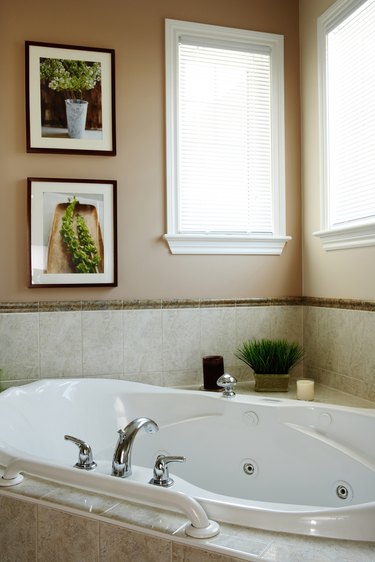Things You'll Need
Paper and pencil
Measuring tape
Rulers
Arc gauges
Framing material of wood or PVC
Nails or PVC glue
Hammer
Foam mold
Cutting tools
Acetone
Sponge
Gloves
Mask
Fiberglass sheets
Resin
Paint roller
Paint tray
Air roller
Flat prying bar
Sander
Drill
Cutting bore bits
Water-resistant caulk

Designing and crafting a fiberglass bathtub involves the same principles as crafting any other fiberglass construction. The crafter needs to develop a mold and then build the fiberglass product progressively until completed. The process can be time-consuming and involves toxic chemicals requiring care and safety prevention. However, a crafter can produce a custom-shaped bathtub not available anywhere from commercially designed products.
Step 1
Look at the room where you want to install the new bathtub once it is built. With pencil and paper, design and map out the size of the bathtub you want to build. Pay attention to angles and the size of arcs desired. Measure these dimensions out with rulers, measuring tapes and arc measurement gauges and notate the information to your design on paper.
Video of the Day
Step 2
Use the dimensions in your design to create a tub frame. Use wood and PVC pipe connected to each other with PVC glue or hammer and nails to build the sizing skeleton of the mold. Take foam mold and insert the pieces into the frame to create the body of the mold. Cut the foam with cutting tools such as razors and knives. Shape the foam to create the inner surface of the mold. Match the shape to your tub dimensions, adding and removing foam as necessary to create the mold shape.
Step 3
Use scissors to cut out appropriate sheets of fiberglass cloth so that you can handle them as you build the tub itself. Clean the inner mold surface wall with acetone and a sponge. Wear gloves to protect your hands. Spray the finished mold with a nonstick wax application so you can separate it from the tub later on. Buff it out to smooth the wax on the inner surface as needed.
Step 4
Mix fiberglass resin and pour it into a paint tray. Apply the resin to the inside of the mold with a small painting roller after dipping it in the tray. Lay a fiberglass cloth sheet after the first resin layer is applied. Use an air roller to flatten the cloth into the resin. Cover the service and keep applying cloth sheets until the first layer is installed. Cover all the first sheets with more resin. Let the layer dry for a few minutes and repeat the process for at least two or three more layers. Let this first phase dry inside the mold for an hour.
Step 5
Apply additional layers of cloth and resin until the tub surface reaches the desired thickness of fiberglass resin and cloth covered with more resin. Try to make sure that the thickness measures at least 20 mm. Smooth out each layer as it is applied, to avoid air bubbles. Let the final layering dry and cure while you clean up the remaining resin, equipment and extra cloth.
Step 6
Begin the process of separating the cured fiberglass tub two days later. Separate the tub from the foam using a separator tool such as a flat prying bar. Pull the tub shell out and carefully place it in a free workspace. Sand the edges and the surface to smooth them out in every area. Remove any sharp edges as necessary.
Step 7
Identify the tub hardware hole locations and the drain location. Cut these cavities and holes using a drill and bore bit sized to the plumbing equipment that will be installed in the tub. Sand the edges of the holes so that they are clean cuts when finished. Paint the finished tub with a thick epoxy paint and surface finisher so that the unit is ready to be used once installed. Apply multiple coats to produce a clean finish.
Step 8
Wait for the painted tub to dry. Install the fiberglass tub into position in the bathroom once you have built the surrounding tub frame and counters as desired. Connect the plumbing hardware and test the system to make sure there are no tub leaks. Seal the final exterior edges of the tub to the surrounding counter frame with a water-resistant sealant caulk.
Tip
Take your time when building the fiberglass tub. Don't rush the job. Instead, apply each fiberglass layer carefully to create a smooth, thick surface. Then you'll be happy with the results when finished.
Warning
Always use a mask and gloves when working with fiberglass and resin. Both are chemical-based and can cause serious skin irritation and injury.
Make sure when installing your tub and plumbing the connections are made per your local building code. If not, the issue will come up again when you try to sell the house.
Video of the Day